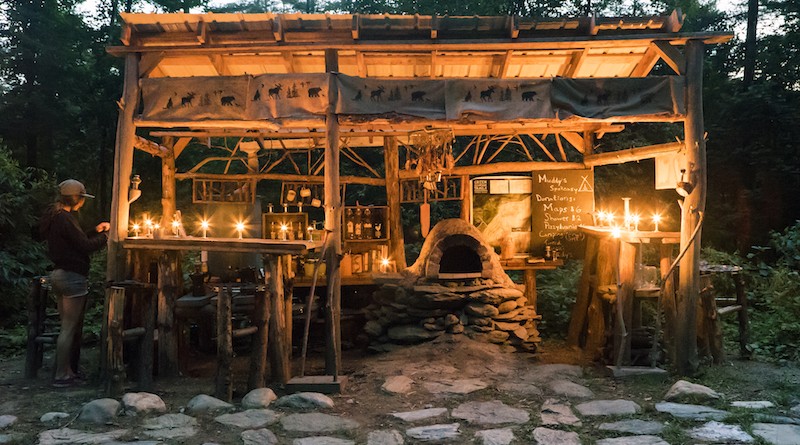The Accidental Glamper
Just north of Killington, The Green Mountain Trails are one of the state’s best-kept secrets for hikers, mountain bikers and now, campers and pizza lovers. Trail keeper Matt Baatz is one of the reasons why.
Eight miles north of Killington, before you come to the tiny town of Pittsfield, the Tweed River valley widens into open meadows. A covered bridge, serving as a driveway, crosses the small creek. On the other side, a picture-perfect yellow farmhouse sits next to a massive, and equally perfect, red barn. This is Riverside Farm, part-time home to former Wall Street executive and Spartan race founder Joe De Sena.
The former horse farm now serves as headquarters for De Sena’s increasingly brutal series of elite survival races—first the Death Race, now the Agoge. It doubles as a wedding venue, a place where New Yorkers don’t hesitate to drop $50K for the ultimate rural Vermont setting. And the trails around the farm serve as De Sena’s private playground, one that he generously opens to the public.
To the west of the farm, the Green Mountain Trails wind for 25 miles up and down the mountains and forests, flowing around more than 100 bermed switchbacks, climbing 1,000 feet in elevation to a cleared meadow at the summit where an old stone cabin, Shrek’s cabin sits. From there, they descend into the valley, and spill out at another De Sena property, Amee Farm Inn, and Sweet Georgia Pea farm.
One hot summer day I followed one of the trails that leads west up the mountains. I climbed the stone stairs (the fruits of a past Death Race where competitors were challenged to carry and place the massive granite steps). But a third of the way to the summit, a side trail caught my eye. Wandering off I came on a clearing.
In the clearing, a bar was set up with rough-hewn branches framing it and a tin roof. Ball jars holding tea, rice and beans were neatly stacked in shallow crates, along with cookbooks. A small, homemade pizza oven stood in the shelter of the bar. A stone-paved walkway led to a fire pit where a wrought-iron pot hung.
Up the hill form the incongruous scene, stood a white safari tent on a wood deck. From it emerged an elfin figure with a big grin. “Welcome to Muddy’s,” said Matt Baatz.
On Facebook, Matt Baatz explains Muddy’s like this:
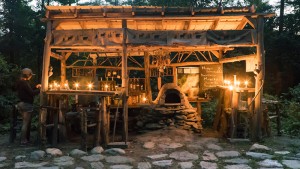 Think of Muddy’s as your timeline with people, other animals and events scrolling by it all day albeit at a much slower pace. You wake up to the turkey frantically pacing and gobbling a couple of switchbacks lower. As you gather kindling for the morning fire, you scare up the family of deer bedding down near the stone wall on Noodles. Coffee in hand, you see the same mountain biker pedal by at six-something each morning and he always jokingly orders breakfast. The red squirrel gnaws at the plastic lid of your peanut butter, manages to open it, knocks it over and feasts. He climbs to the top of the Spokeasy roof and chatters making sure that you know you’re his bitch now.
Think of Muddy’s as your timeline with people, other animals and events scrolling by it all day albeit at a much slower pace. You wake up to the turkey frantically pacing and gobbling a couple of switchbacks lower. As you gather kindling for the morning fire, you scare up the family of deer bedding down near the stone wall on Noodles. Coffee in hand, you see the same mountain biker pedal by at six-something each morning and he always jokingly orders breakfast. The red squirrel gnaws at the plastic lid of your peanut butter, manages to open it, knocks it over and feasts. He climbs to the top of the Spokeasy roof and chatters making sure that you know you’re his bitch now.
A family makes a “wrong” turn into the site and either says “This is so cool,” “What is this?,” or “The landowner let them do THIS?”
Dennis O’Brien comes by around dinner after a group ride and tells you about his chainsaw exploits and you thank him profusely because he’s the main reason the trails are running like clockwork.
You may fire up the pizza oven and someone will ride by and act as if it’s the first time they’ve seen a pizza. The blue jays fly in during the evening and perch on the white pines encircling the site and give a little concert, not the most tuneful, but they mean well. Then the bats swoop over the area for insect control and the Big Dipper appears through the tree clearing.
Some coyotes yip somewhere off in the distance, and that’s pretty much all we got for a curfew alarm here in Pittsfield.
Matt Baatz is an enigma. His Facebook profile lists him as: Head Dough-Stretcher at Muddy’s Hut; Trail Manager at Green Mountain Trails; former Burpee Specialist at Puddy’s. His profile page claims he studied cryptozoology (the study of creatures whose existence has not been validated—think Sasquatch) at Penn State. He is pushing 50 but looks 30. His high-tops have no laces. There is a childlike innocence around him that is both honest and charming.
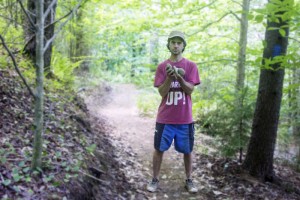
In person, Baatz admits that he has a B.A. in English and has spent much of his life WWOOFing (volunteering on organic farms in exchange for room and board, via World Wide Opportunities on Organic Farms). It’s been ten years since he owned a car. He rides a mountain bike with a small trailer through town. He sleeps (when he is not at Muddy’s) at a house De Sena owns across the street and eats most days at De Sena’s Pittsfield General Store.
Baatz hesitates before he speaks, and when he does, it is often to offer up a profoundly articulate musing on life. “So much of what people throw away should be used again. We just don’t think to do so,” he says as he gestures to the things around him, “There’s nothing new here.” He puts it in a way that is less preaching and more matter of fact.
He walks me through the bar, the “Spokeasy,” and shows me stools he fashioned from old bike wheels, their seats woven from old tires. A series of bicycle hubs stand on end, each holding a votive candle. Crates, stacked on ends, serves as shelves.
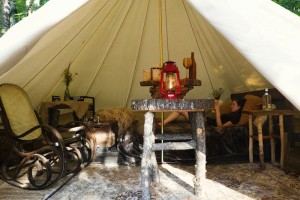 Upslope, the white canvas safari tent is furnished in a manner that anyone who peruses Restoration Hardwear catalogs would drool over. Glass bottles have been fitted with battery-powered lights. Old crates hold books. The queen-sized bed has a barn-board headboard. Threadbare Orientals line the floor. Down the path, an outhouse features a high-backed wood armchair with a hole cut out as a seat.
Upslope, the white canvas safari tent is furnished in a manner that anyone who peruses Restoration Hardwear catalogs would drool over. Glass bottles have been fitted with battery-powered lights. Old crates hold books. The queen-sized bed has a barn-board headboard. Threadbare Orientals line the floor. Down the path, an outhouse features a high-backed wood armchair with a hole cut out as a seat.
“Anyone can stay here,” says Baatz as he waves his hand expansively across the deck where Adirondack chairs peer down on the Spokeasy. “You might be here mountain biking, or passing through on a hike.”
I ask him how reservations work and how much it costs. His brow furrows and he pauses. “I haven’t quite figured that out yet—for now, it’s just free, or you bring some really good beer.”
Last spring, when MTBVt.com’s Ryan Thibault and David Lauzon rode through with a group on a mission to ride as much singletrack as possible between Killington and Hyde Park, they camped out at the Green Mountain Trails. “They asked me to ride with them to Rochester and show them the trails for the afternoon,” Baatz said. “When we got to the Rochester border, they invited me to join them for the rest of the trip.”
Baatz, wearing only the clothes he had on for the afternoon ride kept going for five more days. “Those guys were amazing: they lent me clothes, gave me food and put me up all along the way,” he says of Thibault and crew.
Baatz’s life seems centered around whim and karma; He lives by giving and receiving. “I think it’s that freedom…” he pauses and looks up at the treetops as if counting the leaves, and then continues. “…That freedom to pick up and go for a bike ride, and to live my life when and how I want, that keeps me here.”
“Muddy’s,” Baatz goes on to explain, didn’t start out as his. Baatz inherited the site from another De Sena protégé, Sefra Alexander, who put up the tent and platform and dubbed it “Puddy’s Luxury Wildernest: Vermont’s #1 Glamping Retreat.”
(Baatz winces at the word “glamping.”)
Alexander, who holds a degree in Agricultural Education from Cornell, envisioned holding naturalist hikes, foraging lessons, and forest-to-table meals, coupled with lessons in “rewilding,” wilderness survival skills, mountain biking and yoga.
Alexander’s “wilding” ethos jibed with De Sena ’s philosophy of primitive survival and pushing the limits of physical and mental endurance. Over the years, Riverside Farm has become a business incubator or sorts for all sorts of Spartan offshoot projects.
“Joe has this way of betting on people and hoping they’ll build a business,” says Baatz with a wry smile. “But most of the projects never really work out.”
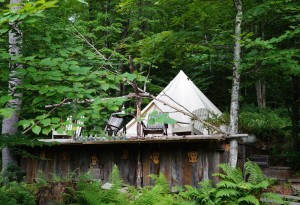 Baatz lent a hand as Alexander went about building the camp. “It was fun at first,” recalls Baatz, who, along with Alexander, went to the Roots School in Corinth for a variety of courses in primitive survival. “Eventually, like a lot of projects that get started here, their visions went separate ways,” says Baatz of Alexander and De Sena.
Baatz lent a hand as Alexander went about building the camp. “It was fun at first,” recalls Baatz, who, along with Alexander, went to the Roots School in Corinth for a variety of courses in primitive survival. “Eventually, like a lot of projects that get started here, their visions went separate ways,” says Baatz of Alexander and De Sena.
Alexander moved on. Baatz inherited the campsite (renamed Muddy’s) and began work on the Spokeasy and the pizza oven he dubbed Pizzylvania.
“I didn’t exactly tell Joe about the pizza oven,” Baatz admits. “It’s not that I was trying to hide it but I just wasn’t sure what he would think.” Baatz began work last spring, digging out the stones and carrying the bricks up the mountain. “The pizza oven, that took me like 600 hours,” he says.
Once it was finished, he realized he needed a pizza peel and headed to the Pittsfield General Store to borrow one. “Joe was in the store having a meeting so I sort of sidled around him got the peel and was about to leave when he stopped me,” Baatz recalls.
‘“What are you doing with that?” Joe says, and starts to question me,” Baatz says. “I wasn’t sure if he was happy about it or not but I later heard that all he talked about for the next day or two was ‘that pizza oven Matt’s building,’” Baatz says with pride.
Then, true to form, De Sena began to think of the pizza oven as a business. In a short video clip titled “The Best Pizza in Vermont — for Mountain Bikers and Hikers Only,” De Sena, the man who has built the Spartan series into a multi-million dollar international business, is seen grilling Baatz, trail builder and dough-slinger:
De Sena: “So if you don’t know about it [Muddy’s], you can’t get a pizza?
Baatz nods: “Yeah.”
De Sena: “And what if you show up and you’re not here?”
Baatz: “That’s part of the mystique.”
De Sena laughs and shakes his head in disbelief: “So not only do you not advertise, but you might or might not be here. It’s completely random….?.”
Baatz: “It’s completely random.”
De Sena: “And what do you charge”
At this, Baatz raises his eyes again, puffs out his cheeks, rocks toe-to-heel, toe-to-heel and finally answers with a shrug: “Good question.”
Baatz now calls Muddy’s “hours” of operation “serendipitous seating.” He elaborates on his Facebook page:
“This is how I imagine it could work: Some days there will be people camping here and, in light of our seating policy, impromptu gatherings among former strangers could take place, bread will be broken, beverages popped. That’s just what you signed up for. Whoever camps here understands they also become the hosts.
Other days there will be no one here at all, and you’ll be bewildered and perplexed, but still happy that a place like this can still exist at all. Of course there will be many days when the oven is firing, pizza is baking and you’ll come by with a gift, an IOU, a donation or a favor and leave having made a reservation for a place you didn’t know you wanted to visit until you came.”
In watching the video, there is a sense that De Sena, the multimillionaire whom Outside Magazine has called “The Most Punishing Man in Fitness,” on some deep level admires Baatz’s go-with-the-flow approach to life.
Baatz is so far yin to De Sena ’s extreme yang that the relationship seems to have worked
Baatz has been in Pittsfield since he answered an WWOOFing ad six years ago. An avid mountain biker who had been living in Arizona and Mexico, he knew how to build trails.
“When I got here, I was issued a rake and a shovel, I had a place to sleep in the barn and a job making trails,” Baatz says. At first, by Baatz’s account, De Sena pushed him hard. “I think he learned that I’d get things done but I’d do them better if I did them on my own time,” Baatz says. Much of the berms he carved by hand, he cleared and enhanced old trails, using logs and stones from the land.
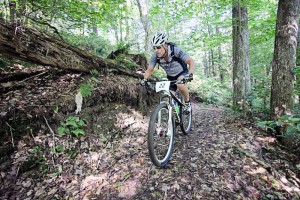 The trails, flowy and often technical, have been the setting for many of De Sena ’s Peak Races and this September 18 will host the GMT Gnarly Adventure which promises to “test your ingenuity as well as your riding prowess” as you attempt to ride all 25 miles of the trail system (“you probably won’t even come close,” the website claims.) or, there’s the classic Six Hour race, which will “cover ten miles of mind, body and technique testing terrain incorporating classic GMT standbys and recently handbuilt gnar including our latest trail, La Gran Aventura.”
The trails, flowy and often technical, have been the setting for many of De Sena ’s Peak Races and this September 18 will host the GMT Gnarly Adventure which promises to “test your ingenuity as well as your riding prowess” as you attempt to ride all 25 miles of the trail system (“you probably won’t even come close,” the website claims.) or, there’s the classic Six Hour race, which will “cover ten miles of mind, body and technique testing terrain incorporating classic GMT standbys and recently handbuilt gnar including our latest trail, La Gran Aventura.”
Along the way, Baatz has been credited with building, much of the tiny trail empire. But it’s a mantle he shrugs off. In response to an article in Killington’s The Mountain Times, he recently wrote:
“I did not build the Green Mountain Trails. For the longest time I wanted to go on public record with that statement dispelling this absurd rumor… As any trailbuilder knows, it would be a John Henryesque task of futility to dig through 25 miles of rugged terrain solo, and probably put me in traction for the rest of my life.”
“Besides, the real story is much more interesting and as quirky as the trail system itself.
The summer before I arrived, a swim team who came from Illinois lived on blue cots in stalls made from canvas sails on the top floor of the Amee Barn. They subsisted on sandwiches from The General Store and a dollar a day wage. They rode in and out of the trails on barely functioning mountain bikes sporting bank logos and helped build the trails.
“Before them, there was a retiree who loved manual labor so much, that he would do it “unbidden for at least 10 hours a day. If you search diligently enough, you can find a video of him competing in one of the earliest Death Races in dress pants. He would spend so many hours grooming the trails that he earned the nickname, “The Rake.” He wore his tool down to the nubs.
“There was a woman I never met named Moe who lived in The Peck House, so called because it was renovated from an old Amee Farm chicken coop. I have no idea what happened to her, but I’d like to swap stories one day. Of course, there was Jason Hayden. who spearheaded the original Pittsfield classics, and, as his wife April describes, was always out working on them.
“Then there was Charlie Bowen, Charlton Heston on an excavator, who probably hasn’t stepped foot into a bike shop in 30 years, but could tie his shoes with the mini-ex bucket. Everything that was machine built, which is a good portion of the trails, was dug by him. There were the incredible locals, the O’Briens (so frequently and to this day), Ed Sandbourne, the Zieglers, Tony Sudol, the Mockuses and everyone else who will have to forgive my absent-mindedness.
And also, as any trailbuilder knows, a surprising amount of trail is at least partially built by deer, moose, bygone loggers, riders finding their flow, and erosive forces. Irene rebuilt a significant amount of trail, and not necessarily for the worse.
So what did I do? I worked very hard for seven years trying to preserve the spirit of something unique and wonderful. It’s the best job ever.
In some ways, Maat Baatz may be even more successful than his boss.

